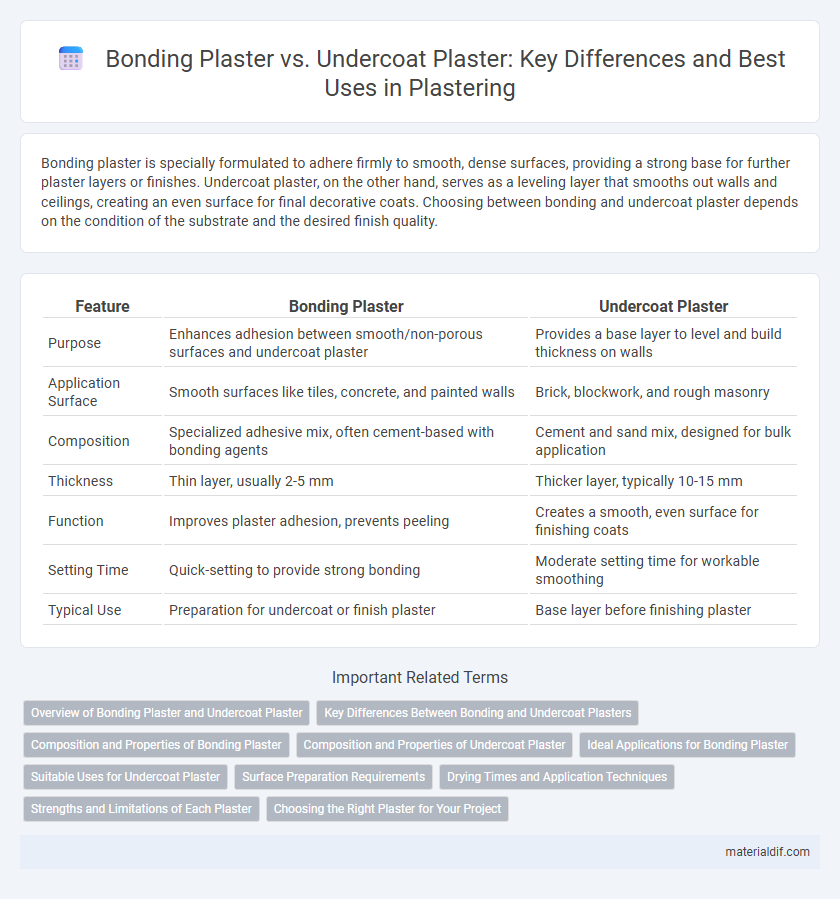Bonding plaster is specially formulated to adhere firmly to smooth, dense surfaces, providing a strong base for further plaster layers or finishes. Undercoat plaster, on the other hand, serves as a leveling layer that smooths out walls and ceilings, creating an even surface for final decorative coats. Choosing between bonding and undercoat plaster depends on the condition of the substrate and the desired finish quality.
Table of Comparison
| Feature | Bonding Plaster | Undercoat Plaster |
|---|---|---|
| Purpose | Enhances adhesion between smooth/non-porous surfaces and undercoat plaster | Provides a base layer to level and build thickness on walls |
| Application Surface | Smooth surfaces like tiles, concrete, and painted walls | Brick, blockwork, and rough masonry |
| Composition | Specialized adhesive mix, often cement-based with bonding agents | Cement and sand mix, designed for bulk application |
| Thickness | Thin layer, usually 2-5 mm | Thicker layer, typically 10-15 mm |
| Function | Improves plaster adhesion, prevents peeling | Creates a smooth, even surface for finishing coats |
| Setting Time | Quick-setting to provide strong bonding | Moderate setting time for workable smoothing |
| Typical Use | Preparation for undercoat or finish plaster | Base layer before finishing plaster |
Overview of Bonding Plaster and Undercoat Plaster
Bonding plaster is a fast-setting material designed primarily to improve the adhesion of subsequent plaster layers on smooth or non-absorbent surfaces, creating an ideal base for undercoat plaster. Undercoat plaster is a thicker, water-resistant layer applied over bonding plaster or directly on masonry, providing a solid, even foundation for finishing coats. Both types are essential in multi-layer plastering systems, with bonding plaster enhancing surface grip and undercoat plaster offering structural durability.
Key Differences Between Bonding and Undercoat Plasters
Bonding plaster contains coarse aggregates designed to adhere to smooth or glossy surfaces, creating a strong base layer for further plaster applications. Undercoat plaster typically has a finer aggregate mix, providing a smooth, even surface that prepares walls for finishing coats like plaster or paint. The key difference lies in bonding plaster's enhanced adhesion properties, while undercoat plaster focuses on leveling and surface uniformity.
Composition and Properties of Bonding Plaster
Bonding plaster is composed primarily of gypsum, sand, and additives that increase its adhesive properties, making it ideal for application on difficult surfaces like concrete or old plaster. Its fine texture and high adhesive strength provide excellent bonding, ensuring subsequent plaster layers, such as undercoat plaster, adhere firmly without cracking or delaminating. Unlike undercoat plaster, bonding plaster sets quickly and forms a tough, moisture-resistant base crucial for durable, smooth plaster finishes.
Composition and Properties of Undercoat Plaster
Undercoat plaster is typically composed of gypsum, sand, and lime, which provides a smooth and strong base layer for subsequent finishing coats. Its properties include excellent adhesion to masonry surfaces, moderate setting time, and good moisture resistance, making it ideal for preparing walls before applying bonding plaster. Unlike bonding plaster, undercoat plaster offers a thicker and more durable substrate that helps enhance the overall durability and finish quality of interior wall systems.
Ideal Applications for Bonding Plaster
Bonding plaster is ideal for preparing difficult, smooth, or dense surfaces like tiles, glass, or concrete blocks before applying an undercoat plaster. Its formulation enhances adhesion, making it suitable for renovation projects where new plaster must securely bond to existing substrates. Using bonding plaster improves the durability and longevity of subsequent plaster layers in both interior and exterior applications.
Suitable Uses for Undercoat Plaster
Undercoat plaster is ideal for providing a strong, level base on rough or uneven masonry surfaces before applying finishing plaster. It enhances the adhesion and durability of topcoats by filling imperfections and creating a smooth substrate. Commonly used on walls and ceilings in both new construction and renovation projects, undercoat plaster ensures long-lasting, crack-resistant finishes.
Surface Preparation Requirements
Bonding plaster requires a clean, dust-free, and slightly dampened surface to ensure optimal adhesion, making it essential for preparing dense or smooth substrates. Undercoat plaster demands a well-keyed base, often achieved by roughening or applying a bonding agent, to enhance mechanical grip and accommodate subsequent finishing layers. Proper surface preparation for both types prevents delamination and ensures a durable, even application.
Drying Times and Application Techniques
Bonding plaster typically dries within 1 to 2 hours, making it ideal for creating a strong base on dense or smooth surfaces, while undercoat plaster requires 24 to 48 hours to dry thoroughly and is applied in thicker layers to provide an even foundation for finishing coats. Application of bonding plaster involves a thin, smooth layer to ensure adherence, whereas undercoat plaster is applied more generously with a trowel to fill irregularities and build surface depth. Both plasters demand proper curing conditions, but bonding plaster's rapid drying allows for quicker project progression compared to the slower drying undercoat plaster.
Strengths and Limitations of Each Plaster
Bonding plaster offers high adhesion properties making it ideal for smooth, non-porous surfaces, but it tends to be more expensive and less workable than undercoat plaster. Undercoat plaster provides a robust, thicker base layer that fills imperfections and creates a strong foundation for finishing coats, though it requires a suitable bonding coat on smooth substrates to ensure proper adhesion. Choosing between bonding plaster and undercoat plaster depends on the substrate material and desired finishing quality, balancing cost, workability, and surface preparation needs.
Choosing the Right Plaster for Your Project
Choosing the right plaster for your project depends on the surface preparation and finishing requirements. Bonding plaster is ideal for smooth surfaces or old walls where extra adhesion is needed, while undercoat plaster provides a solid, even base for finishing coats on new or rough surfaces. Understanding their specific applications ensures durability and a flawless finish tailored to your construction needs.
Bonding plaster vs Undercoat plaster Infographic

 materialdif.com
materialdif.com